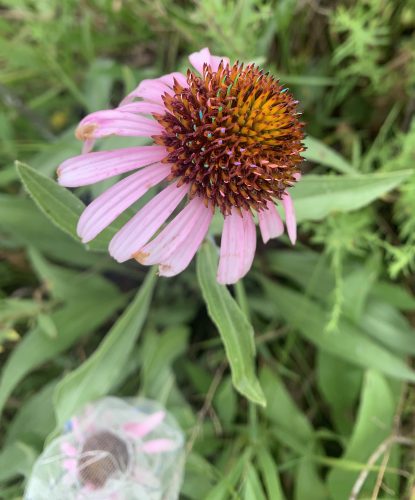The pollen interference experiment series examines the influence of heterospecific pollen application on the shriveling of Echinacea styles. The shriveling of Echinacea styles has previously been considered a signal of compatible pollen receipt, but shriveling can also occur after the application of pollen from other, closely related species without the creation of a viable seed. The pollen interference project aims to determine which species successfully cause shrinkage of Echinacea styles and whether this interference occurs because of an interspecies match in morphology or interparental genetic compatibility.
During the 2019 summer field season, Julie Bailard performed hand-crosses with pollen isolated from individuals of either Heliopsis helianthoides or Ratibida pinnata on styles of Echinacea angustifolia. The goal of this experiment was to determine if heterospecific pollination of Echinacea with closely-related asters resulted in style shriveling. Pollen from each pollen donor was collected in separate microfuge tubes and applied to Echinacea styles the same day, using a fresh toothpick for each donor. In total, 19 Heliopsis and 8 Ratibida sires were crossed with 16 Echinacea dames for a total of 96 interspecies crosses. In 2009, Allegra Halverson applied pollen from Heliopsis helianthoides, Coreopsis, and Carduusonto Echinacea styles and observed that application of Heliopsis pollen often preceded successful style shriveling.
Start year: 2009
Location: exPt02
Data/ materials collected: The data are composed of binary outcomes (y or n) representing either successful style shriveling or style persistence for each pollinated style, recorded 24 and 48 hours after initial heterospecific pollen. Each style’s records are paired with the identity of its maternal plant and the species (application 2009 and 2019) and individual identity code (2019) of the heterospecific pollen donor. Datasheets are found in Julie Bailard’s teamEchinacea2019 Dropbox folder in.
Previously worked on by: Allegra Halverson (Allegra’s pollination data; flog entry)


Leave a Reply